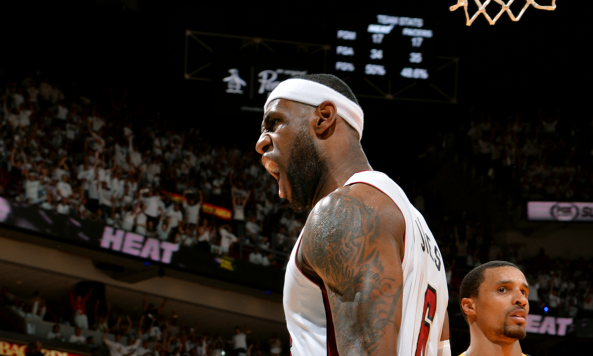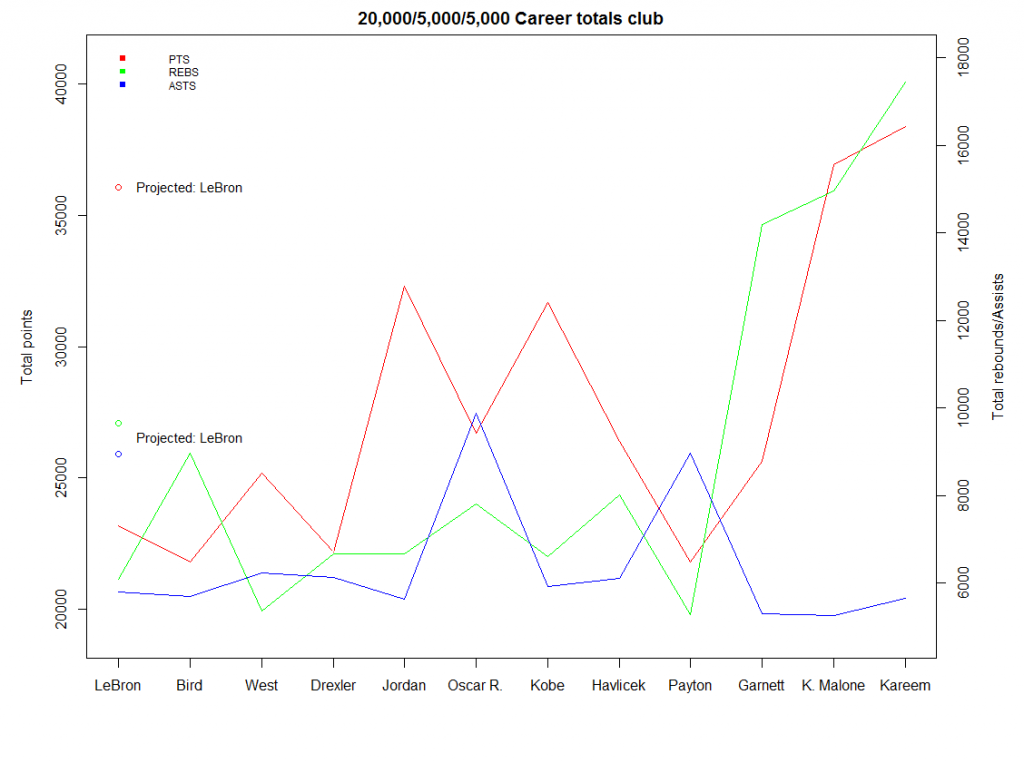Ever since Michael Jordan retired, the media has been on the lookout for the next Jordan. Unfortunately, this meant young superstars were compared to Jordan’s standards, instead of their own merits. Given his high level of play, virtually everyone was being set up to fail, but even if you matched his absurdly high value you would fail for not reaching it in the same manner.
LeBron throws passes even in high leverage moments where the game is on the line, and he’s criticized in the media for not taking the shot – even if it’s the right play. (Never mind that Jordan did the same, like his famous assist to Kerr to win the title in 1997.)
But we’re missing something here.
Jordan, even when surrounded with talented teammates, is an extremely high usage player, taking a large portion of his team’s shots. LeBron doesn’t match him there, but his career averages are seven rebounds and assists a game. Jordan only eclipsed those averages in one season.
We shouldn’t be comparing LeBron to Jordan by how many points he scores; it’s the totality of his game that’s amazing. He’s almost 30-years-old now, and coming out of high school directly to the NBA and playing without any major injuries has left him with career totals that are unprecedented.
He’s not Jordan; he’s some amalgam of Magic and Malone, a point guard in a power forward’s body who appears to be indestructible.
Favorite toy
John Hollinger borrowed a method to predict career totals from Bill James; the method was termed “favorite toy,” as I assume Bill James loved messing with it. Outlined here, given a player’s established level, his totals so far, his age, and his height, one can estimate his projected career totals in various categories and his chances at breaking specific records or thresholds. An established level is just a total we’d expect given the player’s last three seasons, weighing by recency (a 3-2-1 weighting.)
For example, let’s use Kareem in 1977 when he, like LeBron, was still only 29-years-old. His established level is 2159 points per season, and given his height and age he has 6.02 seasons remaining. (Formula: (42-age)/2.2*[60-inches from 6’ 10”]/55.) That means he adds 12,991 more points to his career totals, which were at 18,638, for a predicted total of 31,629. Since his real total ended up being 38,387 and he aged unnaturally well while sticking around for a long time, that’s not a bad estimate. We’d expect a normal player of his caliber to finish around 30,000, like Jordan and Wilt did. Additionally, his chance at hitting 38,387 points based on his stats in 1977 was 15.8%, so it’s still plausible. (Formula: Chance of record = [(remaining seasons*established level)/4amount needed] – 0.5.)
LeBron’s unnatural career stats
Obviously, since LeBron skipped college to play in the NBA he has an advantage over older legends, but it’s his consistency that’s alarming. He doesn’t get injured, and he cranks out a high number of points, assists, and rebounds every year. Consequently, his projected totals are 36,079 points, 9645 rebounds, and 8954 assists, including a 25.2% chance at 10,000 assists.
LeBron would create his own club of 30,000/10,000/10,000, and no one else would be invited. Oscar Robertson would be the closest at 26,710/7804/9887, but there’s another gap between Oscar and anyone else. In fact, the club of 20,000/5000/5000 is exclusive with only 12 players, all of whom are Hall of Famers or soon to be (Garnett, Kobe, and LeBron already.) Comparing him to the 11 other players, LeBron’s projected numbers look incredible and are only matched for Kareem and Karl Malone’s dominance of points and rebounds. LeBron may not have the playoff mystique of Jordan, but he still has a chance at some Kareem-esque career statistics – and that’s rarefied air.
(Side note: the NBA absorbed the ABA and even copied some of its styles and rules, but they do not officially count ABA stats. Dr. J is the “13th apostle” of this group with a little over 30,000 points, 10,000 rebounds, and 5,000 assists.)
The only way to beat Jordan in any all-time discussion is to excel where he fell a little short due to two different early retirements: longevity.
The magic of numbers
Favorite toy has other uses. One of the most intriguing topics is the “what-if” scenario. The league’s history has too many great players who were struck down in their primes.
For example, Grant Hill is one of the few players who approaches LeBron’s all-around brilliance, but a series of ankle injuries destroyed much of his promise. Let’s pretend he didn’t get injured after the 2000 season and enjoyed a full and productive career. Favorite toy estimates his career stats at 23,110 points, 7548 rebounds, and 6136 assists, joining the club above with marks LeBron nearly matches now.
Let’s move on for a more enticing scenario: we can use it to imagine what Magic Johnson’s career would have looked like were it not for the early retirement from HIV. After the 1991 season, he had 17,239 points, 9921 assists, and 6376 rebounds. Given his age and nearly ideal height of 6’ 9” (Hollinger found that the ideal height for aging was 6’ 10”), Magic would have had absurd career totals of 26,047 points, 9330 rebounds, and 15,078 assists. I can’t emphasize how ludicrous those totals would have been. He’d have a great chance at keeping the assist record away from Stockton along with point and rebound totals you’d see from a legendary center, not a point guard.
The only precedence for LeBron’s career raw stats is a fictional and healthy Magic Johnson, but even he is eclipsed. With a three-peat in play as the NBA Finals draw near, let the media draw up the parallels between him and Jordan. But he’s a different beast altogether, some souped-up modern version of Oscar Robertson with three-point range.
History is a sobering reminder of how quickly problems can arise – we can borrow something else from baseball here: the career of Albert Pujols and what happened after he turned 30 – but LeBron has a chance to be truly special.
And for once, Jordan can’t compete.





















